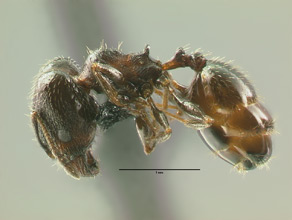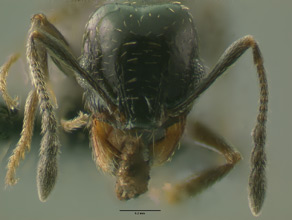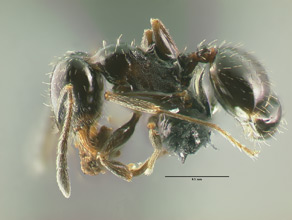- Identification
- The simplest way to distinguish Pheidole from other Navajo ant genera is to find a nest of ants that contains large headed majors and small minors. The 12 segmented antenna of Pheidole ceres majors and minors have a 3 segment club and the propodeum is noticeably lower than the promesonotum. Both the majors (~2 mm) and minors of this ant are small ants and have a pair of spines on their propodeum. Major workers of Pheidole ceres have a head, when seen in full face view, that has carinulae that covers all but the posterior lateral lobes (which are smooth and shining). Workers have blackish brown bodies with lighter colored appendages.
- Biology
- This species was first described in a paper written about western U.S. inquilines (Wheeler 1904) as Pheidole ceres is the host of Pheidole elecebra. Nests are found in open areas, generally under a rock, in a variety of habitats that include ponderosa pine forest, meadow, and sagebrush. Mating flights take place in mid July. In the western U.S. this is the most cold tolerant Pheidole species, occurring at higher elevations than any of its congeners.
- additional biology notes...
- Distribution
- Range
- United States and Mexico. from Wilson (2003) - Foothills of the Rockies in eastern Colorado at 1800-260 m, southwest to the mountains of New Mexico and Arizona, at 220-2700 m, as well as extreme eastern Nevada. Also recorded from the Davis Mountains in Texas and from Guerrereo Mills, in the mountains of Hildago.
- Navajo Reservation Records
- Samples being processed.
- Additional Notes
- Some notes about this ant's general biology and ecology are summarized in Wilson (2003) with many more details being provided by Judd (2005, 2006). His carefully designed experimental work has brought to light much of what we know about this species' biology.
- This ant has a annual production cycle, which is a common feature of many temperate species. Pheidole ceres is an omnivore. Their diet shifts between favoring carbohydrates versus protein over the course of the forging season. This changes coincides with variation in the number and kinds of brood and adult ants that are present in the nest. Like many Pheidole species this species collects and store seeds.
- Judd also provides the following:
- Pheidole ceres (Gregg, 1963) colonies typically nest under flat rocks in open areas with multiple entrances. Multiple entrances enable the colony to exploit multiple food sources simultaneously. Foragers show a strong aversion to direct sunlight and are most active during evenings, mornings, and at night when the temperature is above 10 C.
- It should be pointed out that Wheeler (1904) reported there are from 1 to 5 queens in a Pheidole ceres colony (in his notes about Pheidole elecebra).
- and continuing from Judd:
- Composition of the colonies of Pheidole ceres I surveyed was synchronized throughout their active season (figure above). During the spring (April–May), the brood consisted of both worker (minors and majors) larvae, and reproductive larvae. These larvae appeared to pupate during the early summer (June), and at this time there were very few larvae present in the colonies. The reproductive adults emerged during mid-summer (early July) and remained in the nest for about a month. During this time, there were many eggs and pupae but very few larvae. The reproductives departed at the beginning of August. From that point on, there were both larvae and pupae present for the rest of the ants’ active season (until late October).
- Foraging
- The recruitment behavior of Pheidole ceres was similar to that found in Pheidole morrisi (Johnson, 1988). A single minor (scout) found the food source and fed for approximately 3 min, usually stopping midway for a few seconds. The scout then headed back to the colony. Less than 8 min later, a stream of foragers, usually a few majors and many minors, headed to the feeder from a colony entrance. Once the recruitment to the feeder began, continuous streams of workers left and arrived from it. Scouts showed the same recruitment behavior for both protein and carbohydrate sources.
- The two foraging trails emerged from two separate entrances from the colony. These entrances usually appeared near the edge of the same rock, indicating they are from the same colony. I have occasionally observed majors foraging in the absence of minors. In a few cases, a solitary major arrived at a feeder before any other ant, fed, and then returned to her colony. The major returned to the feeder several times but never recruited other foragers. Thus, only minors appear to recruit.
- Etymology
- Ecological. Ceres is the pre-Roman goddess of agriculture. The name is is presumably a reference to their seed harvesting.

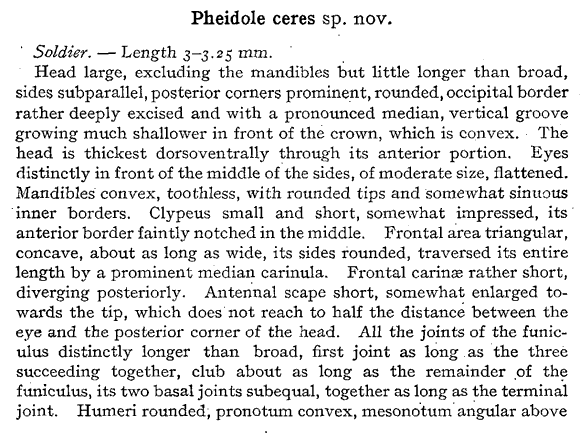
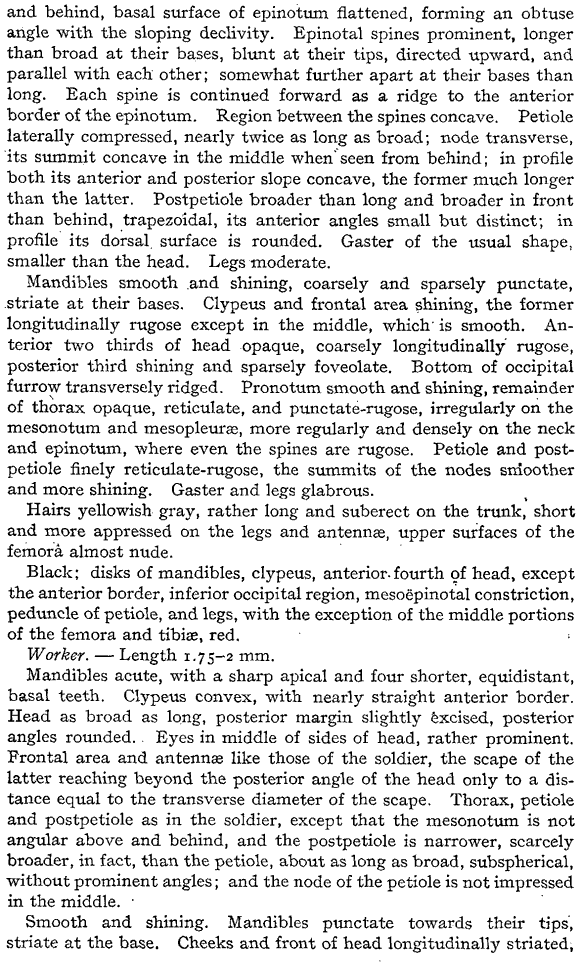
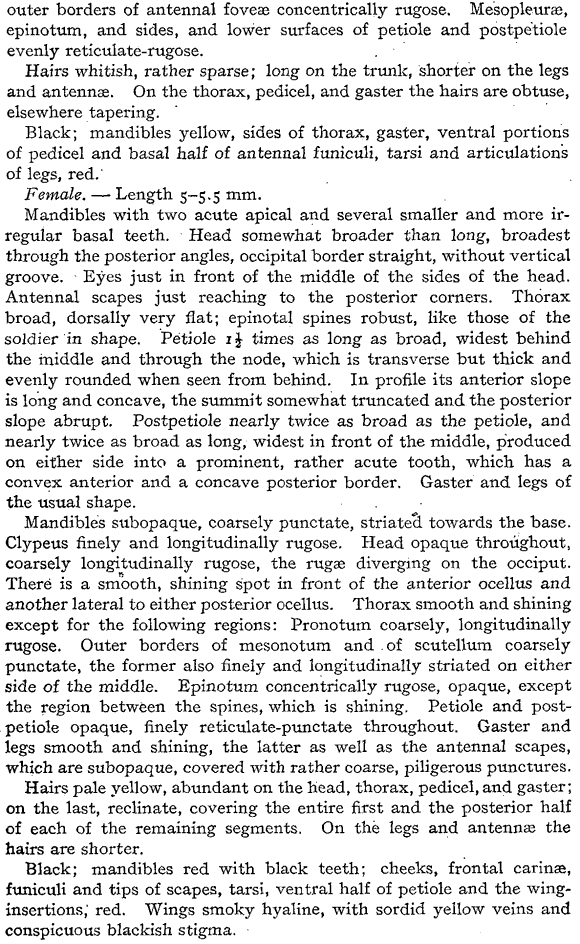
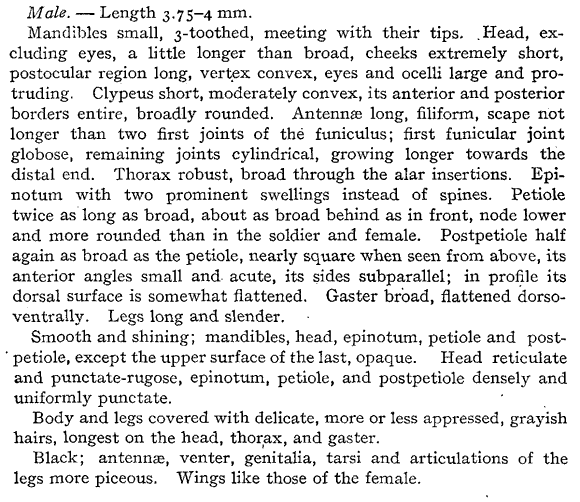
- Literature
- Creighton, W. S. 1950. The ants of North America. Bulletin of the Museum of Comparative Zoology at Harvard University. 104:1-585.
- Judd, T. M. 2005. The effects of water, season, and colony composition on foraging preferences of Pheidole ceres (Hymenoptera: Formicidae). Journal of Insect Behavior. 18:781-803.
- Judd, T. M. 2006. Relationship between food stores and foraging behavior of Pheidole ceres (Hymenoptera: Formicidae). Annals of the Entomological Society of America. 99:398-406.
- Wheeler, W. M. 1904. Three new genera of inquiline ants from Utah and Colorado. Bulletin of the American Museum of Natural History. 20:1-17.
- Wilson, E. O. 2003. Pheidole on the New World: A dominant, hyperdiverse ant genus. Harvard University Press, Cambridge, MA.
- A note about these publications. The literature cited here is not meant to be an exhaustive list of papers published about this species.
Page authored by David Lubertazzi and Gary Alpert

